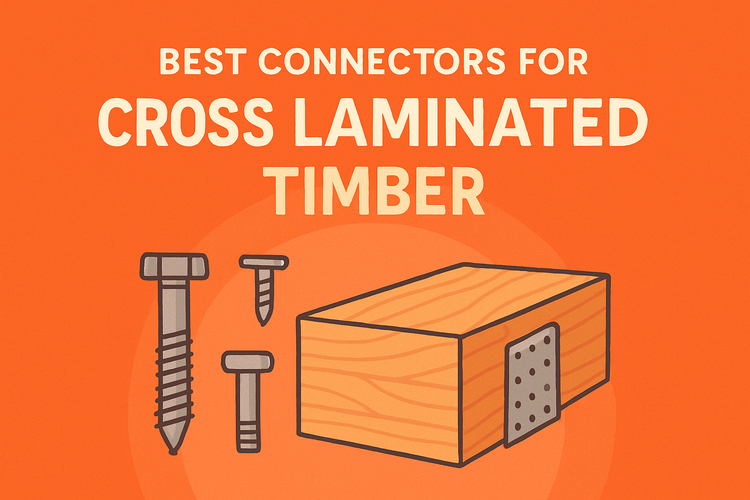Best Connectors For Cross Laminated Timber

Understanding the Importance of Proper Connectors for Cross Laminated Timber
Cross laminated timber (CLT) is gaining popularity for its strength, sustainability, and versatility. Choosing the right connectors ensures its structural reliability and long-term performance.
Unlike traditional timber, CLT panels require specific connectors that accommodate their multi-layered makeup. Utilizing poor-quality or unsuitable fasteners could compromise the design and load capabilities. Carefully selected connectors for cross laminated timber streamline assembly while enhancing structural integrity in modern construction projects.
Joist Hangers: Supporting Load with Precision
Joist hangers play a critical role in safely supporting floor and ceiling joists within CLT constructions. These components effectively transfer loads from horizontal members to vertical supports, maintaining stability under dynamic and static conditions.
With the increasing use of engineered timber, including cross laminated timber, builders choose heavy-duty hangers designed specifically to work with the wider and denser panel format. Options in galvanized steel or stainless steel offer resistance to corrosion and provide secure load transfer. Integrating appropriate joist hangers helps maintain precise alignment of the structure without compromising efficiency during installation.
Moreover, modern hangers cater to seismic loads or large spans, making them ideal for multi-storey residential and commercial CLT buildings. Pre-punched holes allow for quick anchoring, and adjustable flank designs accommodate variable timber depths. Their strategic use not only simplifies CLT assembly but also improves safety and installation speed on-site.
Post Base Connectors for Enhanced Ground-to-Timber Stability
Post base connectors are vital in securing the base of CLT columns to concrete foundations. They anchor upright structural elements while protecting against uplift, lateral movement, and decay from ground contact.
In cross laminated timber systems, accurate and stable ground connection is non-negotiable. Modern post base connectors come with adjustable features and high load ratings that suit the layered nature of CLT columns. Anchoring solutions with epoxy or mechanical fixings help handle tensile and shear forces, ensuring the entire structure remains intact under daily and extreme conditions.
Furthermore, elevated post bases minimize exposure to moisture, preserving timber longevity. This proves critical in exposed applications, such as outdoor structures or first-floor supports. CLT projects benefit immensely from these precision-engineered connectors tailored for strength and weather resistance at the base level.
Angle Brackets: Reinforcing Joints in CLT Assemblies
Angle brackets are indispensable for connecting composite timber panels at right angles. They prevent separation of elements while bolstering lateral and vertical resistance.
Cross laminated timber benefits from robust bracketry that matches its engineered strength. Tailored angle brackets distribute forces evenly across surfaces, reducing stress concentrations at corners or T-junctions. Reinforcing these intersections ensures that load paths remain uninterrupted, especially under seismic forces or heavy loads.
Some brackets come with stiffeners or gussets for added stiffness, making them suitable in multi-directional load applications. Their pre-drilled configurations also help streamline on-site connection without error. For multi-storey CLT construction, angle brackets offer an effective way to achieve consistent joint integrity without sacrificing design flexibility or ease of installation.
High Wind Ties & Timber Connectors: Defending Against Nature
High wind zones demand specialized reinforcement, especially for lightweight yet robust materials like CLT. Wind ties and timber connectors ensure resilience against extreme weather effects.
In regions prone to hurricanes or gales, using high wind ties & timber connectors becomes essential. These connectors protect cross laminated timber panels by anchoring them firmly to foundations and other building elements. They prevent uplift and racking, two common structural vulnerabilities during storms.
These types of connectors often come with enhanced hold-down capacity and multi-point connection features. Whether installed in roof-to-wall, wall-to-floor, or column-to-foundation interfaces, they form a robust link. Selecting wind-test-certified types ensures adherence to local building codes and peace of mind for high-performance timber buildings.
Integrating Timber Frame Connectors in Hybrid CLT Structures
Many cross laminated timber buildings use hybrid framing solutions. Timber frame connectors help bridge CLT with traditional wood framework effectively.
Hybrid applications, involving beam and post timber with CLT infill, require flexible, heavy-duty connector options. Timber frame connectors cater specifically to such intersections. They accommodate larger loads and unique geometries without requiring complex on-site fabrication. The right connectors enable seamless integration between mass timber panels and exposed timber frames within the same blueprint.
Additionally, prefabricated timber connectors reduce labour time and lower errors in complex joinery. This is particularly beneficial in tall buildings or custom architectural projects where speed and accuracy are vital. Aligning connector systems from initial design helps avoid retrofitting complications and enhances the overall lifespan and stability of CLT-timber hybrid structures.
